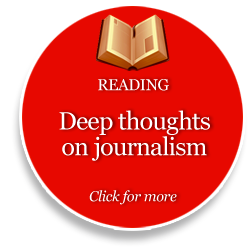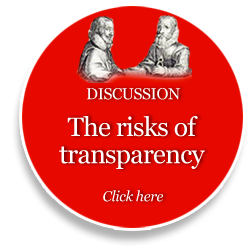Investigative reporting deserves a great deal of attention, not only because it represents journalism at its purest and most potent, but also because it is perennially at risk. In the digital age, the economics supporting this public service work have been totally unhinged. To try to help, Knight Foundation invested many millions in nonprofit investigative reporting. It is easy to see why. Jack and Jim Knight were newspapermen. We’re the only foundation of our size with a platoon of people who grew up in the news business. We know investigative reporting punches above its weight. Even though some stories don’t pan out, all in all, it creates impact far beyond the initial investment.
 Our foundation belongs to the choir, however, and the choir is a closed system. During this past century, America’s tight network of journalists taught itself real professional reverence for the Fourth Estate: Taught itself but often ignored everyone else. Not long ago the Pew Research Center’s Project for Excellence in Journalism released a survey about local news. A headline in the survey deserves attention: Sixty-nine percent of America believes that if local newspapers no longer existed, it would be no big deal.
Our foundation belongs to the choir, however, and the choir is a closed system. During this past century, America’s tight network of journalists taught itself real professional reverence for the Fourth Estate: Taught itself but often ignored everyone else. Not long ago the Pew Research Center’s Project for Excellence in Journalism released a survey about local news. A headline in the survey deserves attention: Sixty-nine percent of America believes that if local newspapers no longer existed, it would be no big deal.
If newspaper news is gone, people think, they’ll just get the news from radio, TV and the Internet. Journalists know that’s not so. Daily papers still produce most of the country’s local news. People do not know this fact. How did the nation become so badly informed about the mechanics of how they are informed?
Journalists are at least partly to blame. We chose not to tell people how news systems worked. We did not want anyone in the kitchen as we alone worked out our recipes for news. The results? Journalists have helped create a nation of functional news illiterates. Sure, the educational system helped a lot, too. But journalists played a big role. Since we did not really understand our communities, we weren’t bothered in the least that our communities did not understand us.
In Orlando, I polled 800 investigative reporters and editors and confirmed a few things. They believe their journalism produces impact. They believe no one understands that. Finally, they believe (at least two thirds of them) that this is not their problem.
I disagree. This is the digital age, the age of the rising value of transparency. From now on, part of a journalist’s job should be to help his or her community understand how news works. Yet most journalists seem to be otherwise occupied. We are still fighting over the cookbook while the kitchen is on fire. Before journalism can open up, its industrial-age workplace culture must change. American newsrooms are among the most defensive workplaces measured. Performing with the perfectionism of a nuclear power plant crew or the strict routine of a military combat unit might sometimes help journalists cover the news. But such cultures can be toxic to innovations.
At the heart of all this is the great, glorious story. The entire 20th Century journalistic gestalt put the story at center stage. Many journalism schools pushed it hard, but they were wrong. The story is not the only thing that matters. An extraordinary story by itself may not change the world. An amazing story may not even be seen. A wonderful story might cause no change at all. Someone must absorb it, share it, act on it and pay for it.
I learned this the hard way. One investigation I put on the front page would produce immediate change, say an emergency water rationing law within 24 hours. But another — almost scientific in similarity, by the same people, same quality, same display, same day of the week, only the topic different — would trigger no reaction at all, not even a call or letter. Clearly, something mattered that had nothing to do with our journalism; that something was the community.
Communities would have a word with journalists not just about story selection but also about fundamental storytelling skills, if we asked. Accuracy is an issue: Every single day journalists still wrongly portray giant swaths of the American community, feeding stereotypes and sewing fear. Context is an issue: Journalists still too often take the cheap, easy, sensationalistic way out, failing to report the news in a context that adds meaning. Fairness is an issue: The idea that journalism must be carried on behind closed doors is inherently unfair to the communities we serve. That inward focus keeps journalists from engaging their whole communities and stifles accountability and transparency.
 Journalists do these things, mostly without even thinking about them, in violation of their most sacred covenant. “Every journalist believes that he or she works, ultimately, for the reader, not for the editor, or for the publisher, or for the corporation, or for those opaque financial institutions that hold the stock,” said John Carroll, who edited three major newspapers with distinction. “We all know journalists who have lost their jobs on principle. They have refused to kill important stories or to write glowingly about politicians or advertisers who don’t deserve it. They have done this because their first loyalty is to the reader.”
Journalists do these things, mostly without even thinking about them, in violation of their most sacred covenant. “Every journalist believes that he or she works, ultimately, for the reader, not for the editor, or for the publisher, or for the corporation, or for those opaque financial institutions that hold the stock,” said John Carroll, who edited three major newspapers with distinction. “We all know journalists who have lost their jobs on principle. They have refused to kill important stories or to write glowingly about politicians or advertisers who don’t deserve it. They have done this because their first loyalty is to the reader.”
Journalistic loyalty to citizen and community begs the question of transparency. Being fair doesn’t just mean reporting the many sides of a story; it also means showing people your side. Let them behind the curtain. Who are you? Why are you doing this story? What objective tools are you using? What’s your news ethic? Showing your work is a best practice in digital journalism, the finished story being only one form of interaction with the public. Networked journalists talk with their communities about what they are working on, solicit tips, post unedited interviews and much more.
For news organizations transparency also means explaining where the money comes from. Knight Foundation, in fact, has adopted a new policy: to receive grants from us, news providers need to reveal their project’s major donors. The best of them don’t need to be told: They already do. The others have misplaced fears. They don’t want to show how the sausage is made because they’re afraid it opens them up to criticism of bias. But keeping the secret is what’s making them look bad.
Can investigative reporters further open up the way they work?
Let’s take the book by Thomas Peele, Killing the Messenger, about the story leading up to Oakland journalist Chauncey Bailey’s murder. As you know, the Chauncey Bailey Project led the journalism that found the killers. The district attorney credited the project with a glowing testimonial. As you probably do not know, Peele’s voluminous tome left out the quote. The book tells people everything about the murder except one thing: that the journalism mattered.
Who speaks for journalism? Book reviewers don’t focus on it. Readers don’t know about it. The Chauncey Bailey Project has won more than a dozen awards given by journalists to journalists. It has been explained at the conferences given by journalists for journalists. It will be taught to the students of journalism, up-and-coming members of the choir.
Highlighting impact
If they can muster just a fraction of the passion they use to chase the news, journalists can better explain their profession through open contests and open conventions.
Journalism contests have proliferated. Just the major ones number roughly 200. If you count regional awards, there are thousands. If the prize is big enough, news organizations tell their audiences they won. That’s not the same as reaching out to the legions of people who don’t know where their local news really comes from. If our contests cared about communities, not just journalists, they would help people know how the journalism happened and why that mattered.
Suppose a great investigation gets a state to release earthquake safety funds for schools. If an open contest picks the story as a winner, the contest organizers would then alert PTAs, teacher organizations, administrator’s organizations, even state officials in the place where the journalism made a difference. The contest sends letters, posts on Facebook, blogs, emails, does videos and holds community meetings explaining the winning story. Why do this? Because, the contest would explain, the role of journalism is not understood. I’m still waiting for that sort of contest to happen.
 Journalism conferences also have multiplied. Why should any conference of journalists take place without at least one session involving leaders and citizens of the host community? If investigative reporter and professor Lowell Bergman can get CIA and FBI officials to come to his Logan investigative reporting symposia, certainly a more mundane journalism convention could attract a mayor, city council or other community leaders. In those sessions, attendees take apart the news flows, talk frankly about them, hear complaints and offer suggestions.
Journalism conferences also have multiplied. Why should any conference of journalists take place without at least one session involving leaders and citizens of the host community? If investigative reporter and professor Lowell Bergman can get CIA and FBI officials to come to his Logan investigative reporting symposia, certainly a more mundane journalism convention could attract a mayor, city council or other community leaders. In those sessions, attendees take apart the news flows, talk frankly about them, hear complaints and offer suggestions.
Open contests and open conventions would create thousands of new community encounters every year. Yet they don’t exist.
Professional organizations and publications can help explain the role of journalism by focusing more on its impact. They can show how to track it, explain how to be accurate and not self-serving when reporting it. Where there is no impact, they can unpack those projects and see where they failed to engage people.
Journalism schools could explain the role of journalism by teaching 21st century literacies — digital, media, news and civic fluency — to every student in their universities. Understanding the role of journalism should be part of those literacies. Yet those who teach news literacy too often fail to use the techniques of the digital world. By failing to hop on that bus, they’ll likely be left behind. Such books as Detecting Bull are just not enough. Eventually, digital media literacy will be digitized itself and integrated into K-12 schools, and become a general education requirement for college graduation.
There are some 100,000 general news journalists in America. There are perhaps 220,000 journalism and communication students and professors, and some 500,000 people loosely categorized as doing nonfiction editorial work. If we open up, change our orientation to reach outward, we could engage millions. If each had 400 Facebook friends, journalists could engage the entire nation. The problem is that journalists whose list of friends doesn’t include many other journalists are hard to find.
To have a conversation about why journalism matters, we also would have to listen to those who find news, as it is presented today, too boring, too negative, too slanted or simply out of touch. If we truly listen and engage, we will begin to see why some of our work causes instant change and other stories do absolutely nothing. By thinking beyond the story, in the end we can help the story.
 There is an as-yet-undiscovered science of impact. Do stories create more impact when people think that their communities can actually fix the problems? When they have the groups, tools or systems to fix it? What makes them consider this particular problem a priority? These are complex questions. They dovetail with network theory and ideas about social capital. Two foundations, Gates and Knight, are hoping insights on digital media impact will come from a major project we’ve funded at the University of Southern California.
There is an as-yet-undiscovered science of impact. Do stories create more impact when people think that their communities can actually fix the problems? When they have the groups, tools or systems to fix it? What makes them consider this particular problem a priority? These are complex questions. They dovetail with network theory and ideas about social capital. Two foundations, Gates and Knight, are hoping insights on digital media impact will come from a major project we’ve funded at the University of Southern California.
The primary colors of journalism
Producing good journalism is difficult. It deserves more respect. If journalists are more open and in better conversation with the communities they serve, that will help. But that’s also hard to do, especially for the older generations, because it requires breaking habits and taking on a new view of a world that is changing almost beyond imagining.

At the start of the 20th century, Crayola hoped to help young artists see the world with eight basic crayons. The first colors were red, orange, yellow, green, blue, violet, brown and black.
Around this same time, English writer Rudyard Kipling summed up the basic way journalists explained the world with these lines in “The Elephant’s Child”:
“I keep six honest serving-men
(They taught me all I knew);
Their names are What and Why and When
And How and Where and Who.”
 How has the world changed in the past 100 years? We have blasted off to worlds beyond Crayola’s eight basic crayons. Search the Web for modern computer color, 36-bit color, and you’ll see it supports not thousands nor even millions but, they say, 68.71 billion colors.
How has the world changed in the past 100 years? We have blasted off to worlds beyond Crayola’s eight basic crayons. Search the Web for modern computer color, 36-bit color, and you’ll see it supports not thousands nor even millions but, they say, 68.71 billion colors.
So what about journalism? How many billions of bits of new meaning do our digital tools support? Certainly visual journalists can benefit from a world of infinite color, but what of the rest of them?
Kipling realized his serving-men had limits. The poem concludes:
“I let them rest from nine till five,
For I am busy then,
As well as breakfast, lunch, and tea,
For they are hungry men.
But different folk have different views;
I know a person small—
She keeps ten million serving-men,
Who get no rest at all!
She sends ’em abroad on her own affairs,
From the second she opens her eyes—
One million Hows, two million Wheres,
And seven million Whys!”
Today’s children, the digital natives, are growing up in a world where new tools can express reality in all its billions of colors. We digital immigrants need to drop our old ideas of what journalists can do and use the power of the digital age to program billions of “serving men” in search for true things. Or never mind programming; we could just ask the billions of serving people who now make up the population of this planet.
The alternative, sticking with the old frameworks, leads only to despair. The membership in Investigative Reporters and Editors, for example, is still down significantly from its peak of 5,000. The American Society of News Editors census is grimmer. Its latest total is 36,700 daily newspaper journalists, down from the peak of 56,900 in 1990. Daily paper newsrooms are operating at staffing levels not seen since the 1970s. Put simply, there are 20,000 fewer cooks in the kitchen.
Yet the collapse of the newspaper’s economic model is not the collapse of news. Print newspaper advertising is in free fall. But Web traffic is up. We have new “power tools” — super sunglasses that allow us to filter data without the journalistic armies of old. New organizations such as the Investigative News Network and new digital news outlets are rising. The Online News Association is booming. Student journalism is rising. NPR looks good. Journalistic bloggers are emerging. Crowd-sourcing and volunteer reporting are gaining momentum. Social media floods us with breaking news, even real-time, on-the-scene alerts on events such as the Boston Marathon bombing.
The closed systems, the inward-looking systems, are collapsing. The open systems, the outward-facing ones, are growing. There are thousands of new digital companies born each year with billions of dollars in venture capital, many of them looking to be the new curators, verifiers and platforms for news and information. They seek to be resources for talent. They are well designed, continuously interactive and looking in earnest for the personalities, digital and otherwise, of the niche communities they seek to serve.
Once we get caught up in this new age, some believe news flows will rearrange themselves and new business models will eventually emerge. But tomorrow is not today. In the meantime, we can’t solve our most difficult problems without journalism that holds society accountable. We don’t know if our communities will become worlds of extreme distrust or vibrant social action, whether they will be hyper-connected or broken apart by sharp class divisions. We do know, however, that the future requires transformational leaders in news with the courage to try new things, not folks who have played the survivor game at their news organizations and just don’t have anywhere else to go.
The digital age demands a new focus on filters and context, on not just verification but also curation and interpretation. It needs people who want not to dismember systems piece by piece but start over with a new design. We need to listen to news people like Larry Kramer, who argues in his book “C-Scape” that since every company is now a media company, curation is a job that can’t be ignored. We need to find the people today who are ready (as visionary journalist Bob Maynard was two decades ago) to describe their news organization as “a geographically discrete dynamic database” and “an instrument of community understanding.” Were he alive today, Bob likely would have said newsroom transparency is mandatory, and that knowing enough about where we live to help our neighbors see why journalism matters is not a lofty goal but the very least we can do.
This is an updated version of a talk presented at the Logan Symposium on Investigative Reporting at the University of California at Berkeley.
- OFF
- ON
-
‘Time to change journalism’
-
If investigative journalists don’t explain…
-
The story is not all that matters
-
Journalists should like the #opendata movement
-
Ready for ‘open journalism’?
-
What community foundations say about local media
-
Arts: A local affair
-
Does media innovation encourage voting?
-
A nameless idea that lingers
-
A community convention







 Learning layer directory
Learning layer directory
